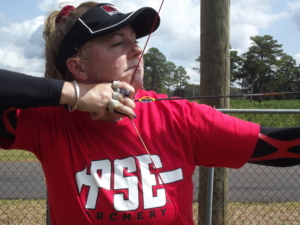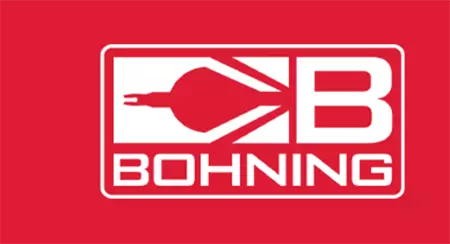The Best Fletching Options for your Olympic Recurve Arrows: understanding the benefits and drawbacks
Bohning Archery makes the number one-selling vane in the world (the Blazer® Vane), so we field a lot of questions about vanes. In the world of Olympic style shooting, we’re asked questions like: Can I shoot plastic fletchings with a recurve bow? What’s the best vane size for Olympic recurve? Spin wings vs plastic vanes, which is better?
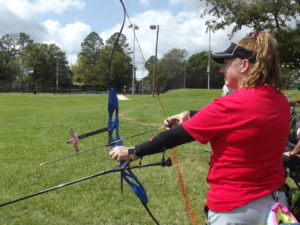 Outdoor Archery with Small Diameter Arrows
Outdoor Archery with Small Diameter Arrows
Olympic recurve archers have a lot of equipment choices to make – will you opt for Hoyt or Win & Win risers and limbs, Easton X10 or Carbon Express Nano Pro X-Treme arrows, Axcel or Shibuya sights? And those are just the big ticket items. There are a lot of small components to consider as well. In this article we’re going to walk you through your options for one of those items: vanes.
The Advantages of Plastic Vanes for Olympic Recurve archers
In general, you get more stability out of a plastic vane. Larger vanes spin and stabilize arrows quicker, for this reason some Olympic recurve archers choose a plastic vane. For small diameter arrows like Easton X10s, you don’t need a four-inch length vane to steer it, a two-inch vane is plenty. Another benefit of plastic fletchings is that they’re really durable and easy to fletch.
Bohning’s 2” Air Vanes, 1.5” X Vanes and 1.75” X Vanes are very popular fletching choices for recurve target shooting. They’re tough enough to survive a pass-through without tearing, and the low profile gives you plenty of clearance for the clicker and riser.
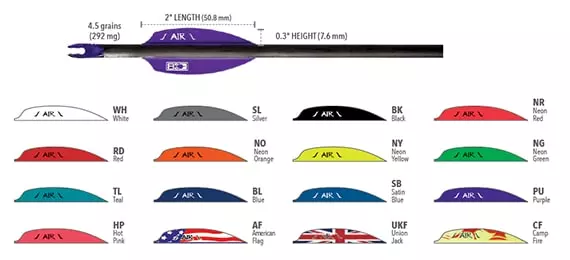
Like all Bohning vanes, the Air and X Vanes are no-prep. Why don’t you have to clean the bases of Bohning vanes before fletching them? Because we extrude our vanes so there is no mold-release agent to clean off. In fact, we pre-prime the bases of all our vanes, so we highly recommend that you NOT clean off the base of the vane as it will remove that primer.
Plastic vanes are really simple to install because you can use any style of quality fletching jig, from traditional styles like the Bohning Pro Class Fletching Jig, to the best plate-style arrow fletching jigs such as our Multi-Fletcher. Using a jig helps you install vanes more accurately, especially when you’re fletching at an offset or helical which is difficult to get perfect if you’re installing them by hand. By using a good archery glue like instant Blazer Bond, or Fletch-Tite Platinum, you’ll rarely see a vane come off the shaft. That’s really convenient as you don’t have to spend your time constantly replacing fletchings.
The Drawbacks of Plastic Vanes for Olympic recurve archers
So what are the drawbacks of plastic (sometimes called “rubber”) glue-on vanes for Olympic recurve archers? Since plastic vanes stabilize an arrow quicker, they also slow it down quicker. When you’re shooting long Field or 3D distances, and especially the 70-90 meter Fita ranges, you want your arrow to maintain as flat of trajectory as possible. Additionally, vanes with a larger surface area are more susceptible to weather-related variables like crosswinds. But spin wing type vanes (also called “mylar” vanes) can have these same drawbacks, especially lateral arrow movement from crosswinds since spin vanes often have just as much surface area as a standard plastic vane. In addition, Spin wing type vanes aren’t advantageous when it comes to durability and convenience. Properly and accurately fletching a mylar vane requires extra steps and a significant amount of time; marking your arrows with a tri-liner, painstakingly applying the double-sided tape to each vane then installing it onto the arrow by hand, and finally, adding the striping tape to the tip and tail of each vane to secure them. Given their fragility and tendency to tear and deform, you have to replace them a lot. That being said, there are a lot of brands out there – Spider vanes, KSL Jet6, the original Range-O-Matic Spin Wings – some are more durable than others. If you’re an archer who already uses spin vanes, none of this is news to you.
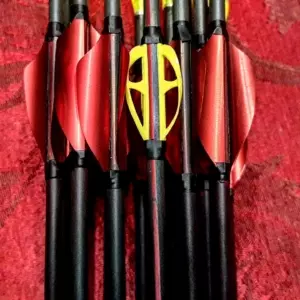 Why many Olympic recurve archers choose spin wing type vanes
Why many Olympic recurve archers choose spin wing type vanes
So with all the drawbacks, why do some Olympic recurve archers use spin vanes? The answer, quite simply, is weight. According to Jake Kaminski, an American Olympian, the fact that mylar vanes are lightweight is the number one reason recurve archers use them. When you remove weight from the back of the arrow, it weakens it, allowing your fingers to make slight mistakes without greatly affecting the trajectory of the arrow. This is the same reason that Easton X10 arrows are the number one choice for high-level Olympic archers (besides the fact that they’re very high quality, of course). X10 shafts are barreled, which makes the back of the arrow weaker, which makes it more forgiving.
A better alternative to spin vanes
You’ve probably heard about Bohning’s new Griffin Vane for Olympic recurve archery. Perhaps, like many archers, you wonder what the benefits of this strange-looking vane could be. Well, quite simply, the Griffin Vane offers optimum performance, durability, and convenience for archers shooting Olympic style bows. At 1.2 grains each, it is extremely lightweight and the reduced profile height provides plenty of clearance for your clicker, arrow rest, and riser. It measures just 1″ (25.4mm) in length and 0.21″ (5.3mm) in height. The minimal “cut-out” surface area means it’s not affected by crosswinds, and the twisted ribbon design aids in arrow rotation which provides steerage. The best part? It’s made of durable, non-deforming vane material, so one pack will last you a really, really long time. Sure, you’ll spend a little more up front, but it’ll save you time and money in the end. READ MORE ABOUT GRIFFIN VANE DEVELOPMENT
Griffin Vane Performance
Olympic recurve archers who tested the Griffin Vane saw their group sizes shrink when compared with mylar vanes, especially in windy scenarios. There are two main reasons for this. First, the “cut-out” surface prevents downrange wind drift, while the integrated right helical twist provides the required spin and steerage. Second, that same cut-out design keeps the grain weight to a minimum, making the back of the arrow weak and forgiving.
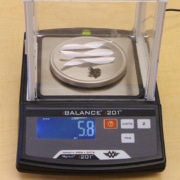
Weight of 2 13/16” Spin Wings with double-sided tape & cap tape: 5.8 grains
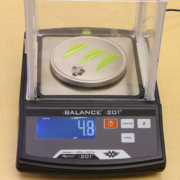
Weight of 1 ¾” Jet6 Vanes with double-sided tape & cap tape: 4.8 grains (weight may change if using shrink tubes instead of cap tape)
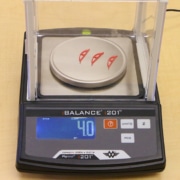
Weight of Griffin vanes with four dots of glue on each base: 4.0 grains
These images illustrate the weight of mylar vanes compared to Griffin vanes. Our scales measure out to one-tenth of a grain. You’ll notice the glass walls – these are necessary because a slight breeze, or even a person’s breath, can throw off the weight measurement.
Durability of the Griffin Vane
To address the main drawback of mylar vanes, we made sure the material we chose for the Griffin Vane was extremely durable. It’s actually a similar material to our Heat Vanes, which is quite a stiff material. Griffin users have reported that, despite shooting groups tight enough to break a lot of nocks, the Griffin Vanes come out unscathed. Your time is precious. Most of us have to find time to squeeze in archery practice. If you can spend a few more hours a week practicing instead of repairing arrows with torn spin vanes, what might happen to your scores?

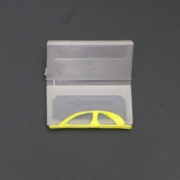
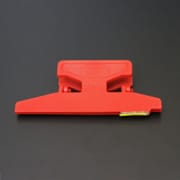
How to install the Griffin Vane
For best adhesion and to reduce weight, we recommend using an instant glue with the Griffin vanes. We identified the average weight of double-sided fletching tape plus striping tape at 1.5 – 2 grains per arrow, while the average weight of glue is 1 grain per arrow. If you use the “dot and spread” method of applying instant glue you can control the amount, and thus the weight, applied to each vane. We know some archers just prefer tape, and it’s not a problem to tape the Griffin Vanes. You will need to use both double-sided fletching tape – we recommend Bohning Premium Fletching Tape – as well as cap tape. A little hint to save you money – if you do use tape you can re-use the Griffin Vanes, moving them from one set of arrows to another without damage.
We manufactured a clamp insert to make it easy for archers to fletch the Griffin Vane with a Pro Class style fletching jig (see video). Because the helical is already built into the design of the Griffin vane, you can install the vane straight. The ability to use a fletching jig eliminates the need to line your arrows, and lets you quickly install vanes much more uniformly and accurately when you’re fletching at home or in the archery shop. We’re also working on a new Pro Class clamp specifically for the Griffin Vane that permits the vane to fit directly and securely into the clamp without having to use the insert – looks for this in late 2021. Like all Bohning vanes, the Griffin Vane is no-prep. We pre-prime the bases of our vanes, so we highly recommend that you NOT clean them as it will remove that primer.
We also know that, though it won’t happen very often if you’re shooting the Griffin Vanes, sometimes you have to re-fletch in the field. That’s why we designed the clamp insert so that you can use it without a jig when necessary. The clamp insert is stored right inside the Griffin packaging, which is very slim and fits nicely in your quiver. Each pack of Griffin Vanes comes with two clamp inserts. The final touch was designing the packaging to securely store the Griffin vanes.
Indoor Olympic Recurve Archery with Large Diameter Arrows
Because of the work involved in getting Olympic recurve setups properly tuned, many archers stick with the same arrow configurations for both indoor and outdoor. There’s nothing wrong with this decision, but for archers who have the ability and time to get a different setup precisely tuned, there are more options.
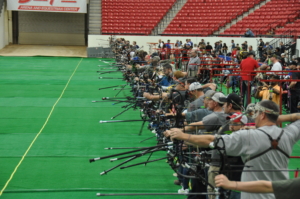 Moving from outdoor to indoor shooting gets rid of two major factors: long distances, and wind. For this reason, some Olympic recurve archers choose larger diameter arrows such as the Easton X23 paired with 3” – 4” fletchings for indoor spots. The 23 diameter arrow provides obvious line-cutter advantages, and larger arrows require bigger vanes or feathers for adequate steering. The great thing is that when shooting indoors, you get all the benefits from shooting a larger vane and few of the drawbacks. They spin and stabilizes your arrow quickly, and the fact that they slow your arrow down isn’t really a negative factor since the distance to the target in indoor is relatively short. Plus, the surface area of your fletching isn’t a big deal since there is no wind, though you do still have to take into account how much clearance your setup offers.
Moving from outdoor to indoor shooting gets rid of two major factors: long distances, and wind. For this reason, some Olympic recurve archers choose larger diameter arrows such as the Easton X23 paired with 3” – 4” fletchings for indoor spots. The 23 diameter arrow provides obvious line-cutter advantages, and larger arrows require bigger vanes or feathers for adequate steering. The great thing is that when shooting indoors, you get all the benefits from shooting a larger vane and few of the drawbacks. They spin and stabilizes your arrow quickly, and the fact that they slow your arrow down isn’t really a negative factor since the distance to the target in indoor is relatively short. Plus, the surface area of your fletching isn’t a big deal since there is no wind, though you do still have to take into account how much clearance your setup offers.
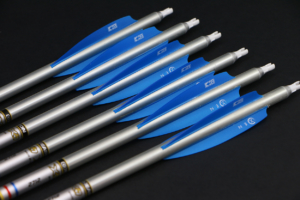
For indoor Olympic archers using large diameter arrows, the choices for fletchings are fairly simple: plastic vanes or feather. Feathers don’t tear when shot through a clicker, and the way they “collapse” upon contact with the riser, plunger, or clicker means arrow flight is not significantly affected. Vanes, however, are far more durable and easier to fletch. If your setup is tuned well enough that contact is not an issue, opting for a vane that is 3-4” in length and very low profile is the better bet. Bohning produces several styles of indoor vanes, but the two that give you the best steerage/clearance combination are the4” Zen vane which measures 0.37″ (9.4mm) in height, and the 3” Bronco Vane which measures 0.43″ (10.9mm) in height.
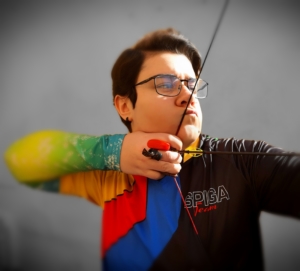
Bohning Pro Staff Team Member Valentina Grieco shoots with Griffin Vanes and Smooth Release Pin Nocks
LEE FORD, TEAM USA – “Hell YES! The Griffin Vanes are AWESOME in the wind! Even during the crazy east coast storms we’ve had, they performed perfectly. And they’re super durable – now when I’m on the road, I don’t have to spend my time re-fletching. Plus, the packaging is sweet – literally, it looks like a fancy chocolate bar, I love it.”
